
Concept explainers
(a)
Interpretation: The product formed on thermal electrocyclic ring opening of the given compounds is to be predicted.
Concept introduction: Electrocyclic reactions involve ring opening or ring closure in a conjugated polyene. According to Woodward-Hoffmann rules, the polyene containing even number of bonds in thermal conditions undergoes reaction in conrotatory fashion and polyene containing odd number of bonds undergo reaction in disrotatory fashion.
Answer to Problem 25P
The product formed on thermal electrocyclic ring opening of the compound A is,
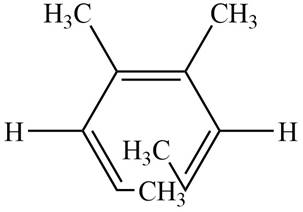
Figure 1
The product formed on thermal electrocyclic ring opening of the compound B is,
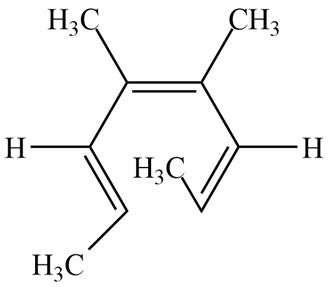
Figure 2
Explanation of Solution
The given compound A is,
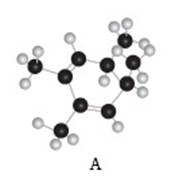
Figure 3
Black coloured atoms have four bonds. So, these are the carbon atoms. The grey coloured balls have one bond. So, these are the hydrogen atoms. The molecular structure is,
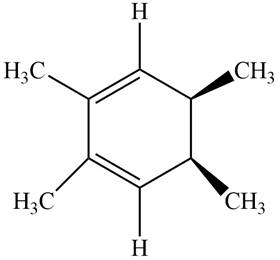
Figure 4
The given compound undergoes thermal electrocyclic ring opening to form product with three pi bonds. According to Woodward-Hoffmann rules, the ring opening takes place in disrotatory fashion. The atomic orbitals of the carbon atoms whose sigma bond is broken rotates in opposite direction. The corresponding

Figure 5
The given compound B is,
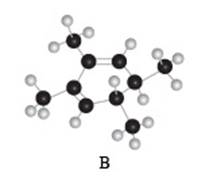
Figure 6
Black coloured atoms have four bonds. So, these are the carbon atoms. The grey coloured balls have one bond. So, these are the hydrogen atoms. The molecular structure is,

Figure 7
The given compound undergoes thermal electrocyclic ring opening to form product with three pi bonds. According to Woodward-Hoffmann rules, the ring opening takes place in disrotatory fashion. The atomic orbitals of the carbon atoms whose sigma bond is broken rotates in opposite direction. The corresponding chemical reaction is shown below.

Figure 8
The products formed on thermal electrocyclic ring opening of the compound A and compound B is are shown in Figure 1 and Figure 2.
(b)
Interpretation: The product formed on photochemical electrocyclic ring opening of the given compounds.
Concept introduction: Electrocyclic reactions involve ring opening or ring closure in a conjugated polyene. According to Woodward-Hoffmann rules, the polyene containing even number of bonds in photochemical conditions undergoes reaction in disrotatory fashion and polyene containing odd number of bonds undergo reaction in conrotatory fashion.
Answer to Problem 25P
The product formed on photochemical electrocyclic ring opening of the compound A is,
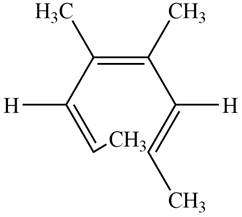
Figure 9
The product formed on photochemical electrocyclic ring opening of the compound B is,
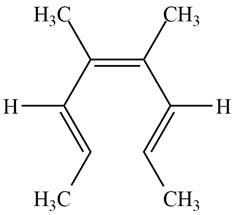
Figure 10
Explanation of Solution
The given compound A is,
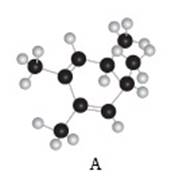
Figure 3
Black coloured atoms have four bonds. So, these are the carbon atoms. The grey coloured balls have one bond. So, these are the hydrogen atoms. The molecular structure is,
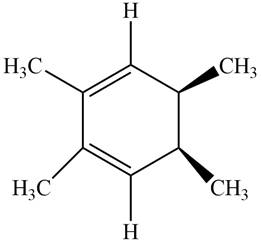
Figure 4
The given compound undergoes thermal electrocyclic ring opening to form product with three pi bonds. According to Woodward-Hoffmann rules, the ring opening takes place in disrotatory fashion. The atomic orbitals of the carbon atoms whose sigma bond is broken rotates in opposite direction. The corresponding chemical reaction is shown below.

Figure 11
The given compound B is,

Figure 6
Black coloured atoms have four bonds. So, these are the carbon atoms. The grey coloured balls have one bond. So, these are the hydrogen atoms. The molecular structure is,

Figure 7
The given compound undergoes thermal electrocyclic ring opening to form product with three pi bonds. According to Woodward-Hoffmann rules, the ring opening takes place in disrotatory fashion. The atomic orbitals of the carbon atoms whose sigma bond is broken rotates in opposite direction. The corresponding chemical reaction is shown below.

Figure 12
The products formed on photochemical electrocyclic ring opening of the compound A and compound B is are shown in Figure 9 and Figure 10.
Want to see more full solutions like this?
Chapter 25 Solutions
ORGANIC CHEMISTRY W/ALEKS
- 8:16 PM Sun Mar 30 K Draw the major product of this reaction. Ignore inorganic byproducts. Proble 1. CH3MgBr 2. H3O+ F Drawingarrow_forwardо но оarrow_forwardName the major organic product of the following action of 4-chloro-4-methyl-1-pentanol in neutral pollution 10+ Now the product. The product has a molecular formula f b. In a singly hain, the starting, material again converts into a secule with the molecular kormula CIO. but with comply Draw the major organic structure inhalationarrow_forward
- Macmillan Learning Alcohols can be oxidized by chromic acid derivatives. One such reagent is pyridinium chlorochromate, (C,H,NH*)(CICTO3), commonly known as PCC. Draw the proposed (neutral) intermediate and the organic product in the oxidation of 1-butanol by PCC when carried out in an anhydrous solvent such as CH₂C₁₂. PCC Intermediate OH CH2Cl2 Draw the intermediate. Select Draw Templates More с H Cr о Product Draw the product. Erase Select Draw Templates More H о Erasearrow_forwardIf I have 1-bromopropene, to obtain compound A, I have to add NaOH and another compound. Indicate which compound that would be. A C6H5 CH3arrow_forwardProvide the reagents for the following reactions.arrow_forward
- If I have 1-bromopropene, to obtain compound Z, I have to add two compounds A1 and A2. Indicate which compounds are needed. P(C6H5)3arrow_forwardDraw the major product of this reaction. Ignore inorganic byproducts. Assume that the water side product is continuously removed to drive the reaction toward products. O CH3CH2NH2, TSOH Select to Draw >arrow_forwardPredict the major organic product(s) for the following reaction.arrow_forward
- Predict the major organic product(s) for the following reactions.arrow_forwardProvide the complete mechanism for the reactions below. You must include appropriate arrows,intermediates, and formal charges.arrow_forwardIndicate the products obtained by reacting fluorobenzene with a sulfonitric mixture.arrow_forward
 ChemistryChemistryISBN:9781305957404Author:Steven S. Zumdahl, Susan A. Zumdahl, Donald J. DeCostePublisher:Cengage Learning
ChemistryChemistryISBN:9781305957404Author:Steven S. Zumdahl, Susan A. Zumdahl, Donald J. DeCostePublisher:Cengage Learning ChemistryChemistryISBN:9781259911156Author:Raymond Chang Dr., Jason Overby ProfessorPublisher:McGraw-Hill Education
ChemistryChemistryISBN:9781259911156Author:Raymond Chang Dr., Jason Overby ProfessorPublisher:McGraw-Hill Education Principles of Instrumental AnalysisChemistryISBN:9781305577213Author:Douglas A. Skoog, F. James Holler, Stanley R. CrouchPublisher:Cengage Learning
Principles of Instrumental AnalysisChemistryISBN:9781305577213Author:Douglas A. Skoog, F. James Holler, Stanley R. CrouchPublisher:Cengage Learning Organic ChemistryChemistryISBN:9780078021558Author:Janice Gorzynski Smith Dr.Publisher:McGraw-Hill Education
Organic ChemistryChemistryISBN:9780078021558Author:Janice Gorzynski Smith Dr.Publisher:McGraw-Hill Education Chemistry: Principles and ReactionsChemistryISBN:9781305079373Author:William L. Masterton, Cecile N. HurleyPublisher:Cengage Learning
Chemistry: Principles and ReactionsChemistryISBN:9781305079373Author:William L. Masterton, Cecile N. HurleyPublisher:Cengage Learning Elementary Principles of Chemical Processes, Bind...ChemistryISBN:9781118431221Author:Richard M. Felder, Ronald W. Rousseau, Lisa G. BullardPublisher:WILEY
Elementary Principles of Chemical Processes, Bind...ChemistryISBN:9781118431221Author:Richard M. Felder, Ronald W. Rousseau, Lisa G. BullardPublisher:WILEY





